Describe your partner
My partner is very quiet. When I first took a glimpse at him, I did not identify anything abnormal about him. He walks a little unbalanced, but that does not make him look strange. We started to ask questions and introduces ourselves to him. He seemed to have understood our words but only replies in limited voice and hand gestures. None of us understood it. Therefore, we found a pen and a piece of paper writing down our conversation. He writes comparatively slow, but the characters are clear to understand. After that, we had a long conversation with his mother. While we are chatting with his mother, I noticed that he is quietly listening and paying attention to our conversation. Later, his mother posted some questions on the paper, and he started writing the response. He even actively started writing a sentence to us while he is a little ignored by us. Therefore, I believed that he has a strong desire to join our conversation. However, the way to communicate is a big challenge for him.
Throughout our conversation with him this time in class, we notice that he relies much on his mother about everything. When we are doing user testing of our prototype to him, he responded indirectly to his mother, and then his mother translates the sign language to us instead of trying to communicate directly to us. Most of the time, he is sitting and observing our communication with his mother as an observer. We then decide to have a conversation with him without his mother. In twenty minutes, we type in sentences on the computer and ask him to reply on paper. The conversation carries out very inefficient since it is hard for him to understand the grammar of a sentence. Therefore, we need to paraphrase a lot to confirm he understand our words. Also, he has limited capability of writing Chinese characters and link them into sentences. We spend much time guessing the meaning by applying body senses. After the conversation, we still think he has a strong inner desire to communicate and experience the outside world more. However, since his mother cares too much for him, it seems that he always wants his mother to help him overcome all the obstacles. Moreover, according to his mother, he likes to play computer games and watch online series at home when he is alone.
After several conversations with him throughout weeks, our communication got even harder and less efficient. As he is now thirty years old, he has already get used to the lifestyle that relies much on others’ help. We think that even though he may have a passion for something, he has already developed a sense of “learned helplessness.” It is too hard for him to step out of his comfort zone and start over again. Because of this, we notice that he is not sensitive to new input from outside. He also blocks himself away from building a new connection to the world with humans and other objects cognitively. Therefore, we believe that even though we tried hard to communicate with him, we still fail to know better about him.
What are their desires/challenges/difficulties?
We got to know that due to the cerebral palsy, he becomes deaf. He is also insensitive and has a problem controlling his left side of the body, including his left hand, arm, leg, and foot. He has many challenges. Throughout our conversation with his mother, we noticed that he never goes out by himself but also with his mother because of the potential dangers on the road. Since he lacks a certain degree of the ability to control the left side of his body, it is tough for him to keep the balance. Also, he expressed his desire to have a romantic relationship with his mother two years ago, but his situation is not socially accepted. Furthermore, his mother is also concerned about his safety at home since he might open the room door for strangers. However, after all, we nearly forget that our target audience should be himself instead of his mother. We were chatting with his mother all the time instead of him. We then realized the most significant difficulty for him is the inconvenient environment of his communication with others. We could hardly communicate with him until his mother came.
When we are communicating with him, we notice that since he is used to relying on his mother so much, he is not comfortable communicating with us directly. He also has little language sense, especially for reading and writing. In our WeChat chat, his mother records and describes how he uses the computer to play games and watch TV series. However, he can hardly control the keyboard using his left hand. We categorize the desires/challenges/difficulties for him in the following points:
- Relies too much on his mother
- Lack of language senses to communicate with others
- Want to build a romantic relationship
- Computer sometimes crashes
- Difficult to click the keyboard with the left hand/arm while playing the game
- Most of all, lack the incentive to try and learn new things
What is your project?
- Project 1: Portable Writing Pad (abandoned halfway)
At first, we intend to build a portable electronic writing pad attached to his body. In this way, he can carry it outside easily to communicate with others by writing everything down, only using his right hand and arm. We also intend to add instruction, either sound or vision, to notify the other to communicate appropriately with him. However, we abandon this idea after the first prototype and user testing since it could not engage him to communicate independently with others, as he says. Therefore, we do not have a final product picture of this project.
- Project 2: foot-control keyboard
After the failure of project 1, by checking his needs listed above, we think addressing no.5 will be most helpful for him. We are thinking about to build a special keyboard for him to press the key using his feet instead of his fingers. For most of the games he plays, they require the use of four keys: “W,” “A,” “S,” and “D” to move the figure. Therefore, we intend to design a four-key keyboard with four direction keys. The keyboard should be on the ground and placed properly so that he can easily step on it. We also want the user to customize the key function to make it applicable to more situations.
Please refer to Nour’s blog post for the picture of the final product.
Development process
- Addressing issues: communication
Our idea is generated during our reflection upon the interaction with our user after the class. We are always spending some time finding a pen and paper to write down words in communication. However, it is not always that convenient to have writing materials everywhere. Also, we did not aware that he is unable to hear and speak at first. Therefore, we came up with an idea to address this problem. So, the purpose of the device should enable him to communicate with others without any barriers in any situation. We still think writing and reading is the most effective, stable, and safe way for his daily communication.
- Research for project 1
We find the existing writing pad online. It is designed by MI (Chinese Internet Corporation), a link to the product. It is convenient to carry, write, and swipe the previous writing. Also, it is very light to carry. The weight of this product is nearly the same as an iPhone. However, it is not initially designed for disabled people. Therefore, we want to build a device that makes the writing pad accessible to him. We need to figure out the following details in design by prototype and test.

- Notify others about his lack of ability in hearing and speaking. We may use the sound notification.
- Attached the writing pad to his body but should not block his daily movement and make him uncomfortable. We may design a special bracket for him.
- Avoid two people writing in opposite directions or make their writing readable to each other. We may want to make the device rotatable.
- Make sure the pen will not be lost while walking. We may attach the pen to the device with wires.
To achieve these goals, we apply some materials in our design of the product. We design to use a belt that could attach the pad to his waist. We also consider that it may not be very convenient for him to have a solid pad in the front all the time. So, the belt also enables him to move it to the side of his leg while not using it.

Then another problem is to make the writing pad standstill in front of him so that he can free one hand from holding the pad to writing. Our idea came from the mobile phone bracket that Didi (Chinese Online Ride-Hailing Platform) drivers use since they also do not have an extra hand to hold their phones while driving.
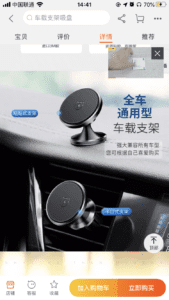
By applying the phone bracket, it also solves the problem to rotate the writing pad so that the two people do not need to read upside-down words.
Since a 10-inch pad is also not small, it may be stuck by his body while rotating the pad. We notice that the small table on the airplane seat can stretch out or fold. How about stretch the pad out a little to leave enough space for him to rotate the pad? Then, we also found a tool online that could make the writing pad movable along the track.
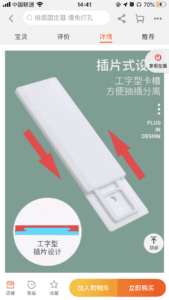
- Prototype for project 1
We did not purchase the writing pad and other materials in the beginning in case it does not fit him well. To test the portability and stability of it, we made a simple prototype of our idea using cardboard and plastic tapes. We use plastic tapes to prototype the belt and the cardboard for the pad. We measure the size of the cardboard and cut it as the exact size of a 10-inch writing pad. Since it is hard to find alternative materials for the phone bracket, we designed another mechanism to prototype it.
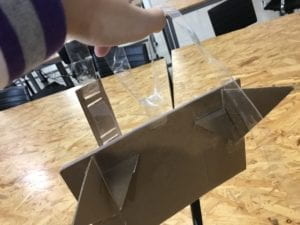
- User testing for project 1
During the user testing session for our user, we addressed many new problems. First, since we are using cardboard and tapes, it is very unstable. However, more importantly, we found out that this product may not necessarily address the issue of his lack of communication with strangers. Since his mother is taking the position of him to answer all the questions, we tried some ways to drive his mother out of the classroom for 15 minutes. During that time, we directly asked him when communicating with others, would he refer to his mother or using a writing pad. He gave us a firm answer: mother. Therefore, among our group, we had an argument about his sense of autonomy and to what extent are we eligible to address such an issue. It becomes a paradox that, on the one hand, the writing pad could enable him to take the autonomy and initiate a conversation that he never has the chance to do before. However, on another hand, he is used to his original way of communication by relying on his mother. His “learned helplessness” is blocking him to try using a new tool because it takes more effort while directly communicating with others. This product could arouse his awareness of active communication only under the condition that he is willing to communicate without his mother. After careful consideration, we decide to postpone this idea since it surely does not work in a short time.
- Research and sketch for project 2
We notice that he likes to play online games. Based on our experiences, sometimes, the player must use both hands to control the game. We have a conversation in the WeChat group asking about what games he regularly plays. This is the website where he usually visits to play online games.

We then visit this website and plays for a while. Indeed, some games require using the left hand to press keys and the right hand to control the mouse. Since most of the time, the player uses the left hand to control “W, A, S, D” to move the figure. Therefore, since he can use his right leg and foot normally, how about take use of it to substitute his left hand?
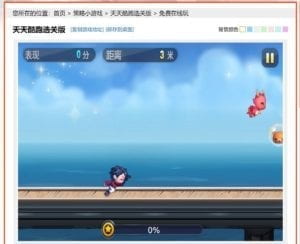
We refer our idea to an interactive Japanese game Dance Dance Revolution. It demonstrates that feet are indeed capable of controlling the game. After practicing and training, feet could also be used quite advanced.

We first think about using a joystick bottom to replace the keys on the keyboard. Four directions of the joystick may indicate four keys. I tried to use my foot to test the bottom. I fear that I may break the bottom at any time. So, we believe that he may easily break it as well by stepping on the bottom too often.
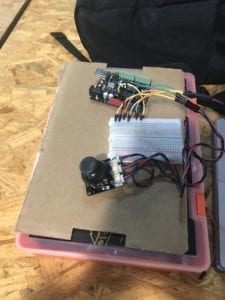
We then searched online for some possible materials for the replacement of keys. We found a pedal that connects to the computer as a key. We then come up with the idea to apply four pedals and build a four-key keyboard on the ground by fixing them on a piece of board.

- Project development for project 2
After we received the pedals, we programed the key information accordingly into the pedals by referring to the instruction. Now, these four pedals can work together as a special four-key keyboard. Since for some games, he may need to press two bottoms together, the problem is how to position them best? We open some online games and use only the right hand and right foot to try playing them. We adjust the position of the four pedals according to our experience interacting with it to find the possible best layout. Finally, we think the photo below shows the best layout.
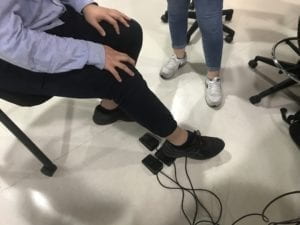
After finalizing the layout, we stock the pedals onto cardboard, waiting for the user testing. We manage to adjust the position of the keys according to the user’s experience and complete the final product.
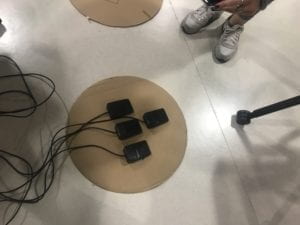
- Feedback from the user
During our final user testing session, we tried to teach him to use the pedals to control the figure in the online game. Yanru did this by demonstrating it to him directly. After a while, he got a sense of controlling it. However, it is not easy for him to get familiar with the control of it. When asking about his experience of using the pedals, he told us that he prefers to use the keyboard than the pedals. We understand the difficulty that even for us, it takes some time to master the use of the pedals by foot. However, due to two reasons, we still think this is not an efficient solution to the problem.
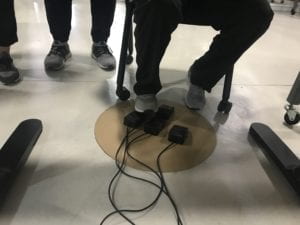
First, as the feedback of our project design says, even though we are designing products for him, we still need to consider the attitude of his mother since his mother plays an important role in his life. If his mother does not agree with the design of the product, she would probably take the initiative against the use of it. This time, we heard his mother’s voice that she is not agreeable to our design since it is complex to use. We also think that it does not reduce the burden of his mother. Instead, it has the potential to bring more troubles to his mother. Therefore, his mother probably will not support his use of these pedals at home.
Second, as described, again and again, he is not open to trying new things since there are always some options for him to pay less effort. Learning to use the pedals takes some time and skill development of his foot. Therefore, in a short time, it would be definitely more convenient to use a keyboard than pedals before he masters them. Temporarily, we have no solution to design a product that does not require any effort of learning and adaption.
What were your difficulties?
- Communication
Communication has always been a difficulty for us throughout the whole developing process. He and his mother seem to have a special system of sign language that none of us understand. The only way for us to communicate without his mother is to write everything down. Even though we can write fast or type on the computer, his comprehensive level is another challenge for us. Because of his limited language sense, we communicate very slow, and it seems impossible for us to communicate deeply. Due to the limited time, we think that we never truly understand and empathize with him by such a shallow and inefficient way of communication.
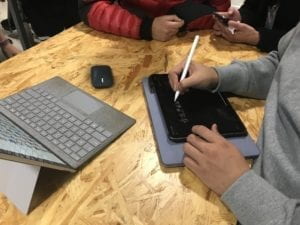
- Defining the USER’s needs that we can address within four weeks
We are always changing our focus on our user since it is hard for us to define his need that we can pay effort on. During our first meet, we had a rich conversation with his mother. We got to know from his mother that he has many problems in his daily life. However, afterward, we consider all these needs as his mother’s instead of his. From his mother’s perspective, she may want something that could make her life more comfortable. However, these issues may not be necessarily relevant a lot to our actual user.
Then, by having a conversation directly with him, we encountered many problems. No matter what specific need we address, it always leads us to a more fundament problem: his autonomy of social life. We had many discussions about his mother’s control over him, his inner desire for social life, his inclusiveness in society, his “learned helplessness” and unwillingness of changes… However, many of these are out of our capability in this course, “Assistive Technology,” which made us at a loss throughout the process. We successfully address the core issue with him – autonomy – but fails to design a product to resolve it from a certain perspective that we can achieve in a short period of time.
- Project development
Project development is also a difficulty for us since we do not have our user to test it at any time we want while developing our project. Therefore, we fail to collect feedback timely. Some designs of the project, for instance, the layout of the pedals in project two may only suitable for us but not necessary for him. Combining with the difficulty of communication, it is harder for us to get positive feedback that engages us for better adjustment and improvement. Even though the final product may not be successful, however, we still believe that our user is enjoying the process of interacting with us. We also learned a lot, as described below. From this perspective, we are having a reciprocal impact on each other, which is a valuable and successful Service-Learning experience.
What did you learn from this 4-week workshop?
- Knowledge about disability
Before the workshop, I only know a little about disability in social media and course readings. I would forget the information in a few hours after reviewing without real-world experience. However, by having authentic communication and interaction with my user who suffers cerebral palsy, I got to know better about the cause and effect of some disabilities, especially different categories and levels of cerebral palsy. By empathizing with my user, I got to know how his daily life is like and how he behaves differently compare to people without cerebral palsy. This is significant for me to be more open-minded and inclusive when designing any form of technology to consider the issue of accessibility.
- Interaction with disables
Before the workshop, I only have a little experience of interacting with blind people while having activities with some NGOs. This workshop gives me the chance to interact with my user in a comparatively long period personally. This is significant for me to have a stronger awareness to be more considerate in the future when interacting with other people with disabilities.
- Social environment and issues with disables
In our conversation with his mother, we got to know the changes of people in Shanghai and the Shanghai government’s attitude towards disables. In recent years, society is becoming more and more inclusive to them, especially in an international city like Shanghai. However, it is still a long way to go. He is always thinking about to have a romantic relationship. However, his mother says that people without severe disabilities would not consider him regarding his physical condition, social identity, future potential income, etc.
- Design thinking
The most fruitful gain for me is the process of applying “design thinking” in an authentic project. I have heard of the notion of “design thinking” over five times in my college life. I was very familiar with the concept of it even before taking this course. However, this course gives me the change to apply it to my project for the first time. I now realize the importance of “empathize” and “define” process in “design thinking.” By reflecting on our not successful project development, I believe we have a wonderful “ideate” process and creative “prototype.” However, during the “test,” we realize again and again that we are always missing some consideration to the user himself. This also corresponds to what we learned in class that the five steps are in a loop. We went back to the first step “empathize” twice after testing! After three weeks, even though we had empathized a lot on him, we are still struggling with the “define” step. In all, I think the updated loop version of “design thinking” is a very useful concept for project development. Among them, “empathize” and “define” processes are especially important.